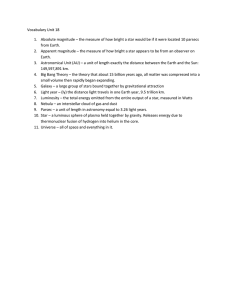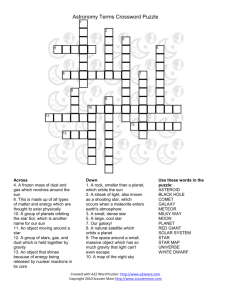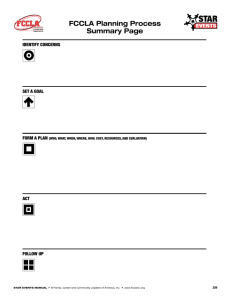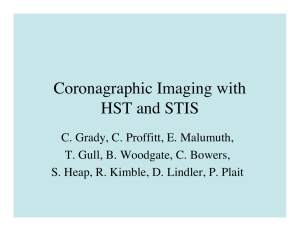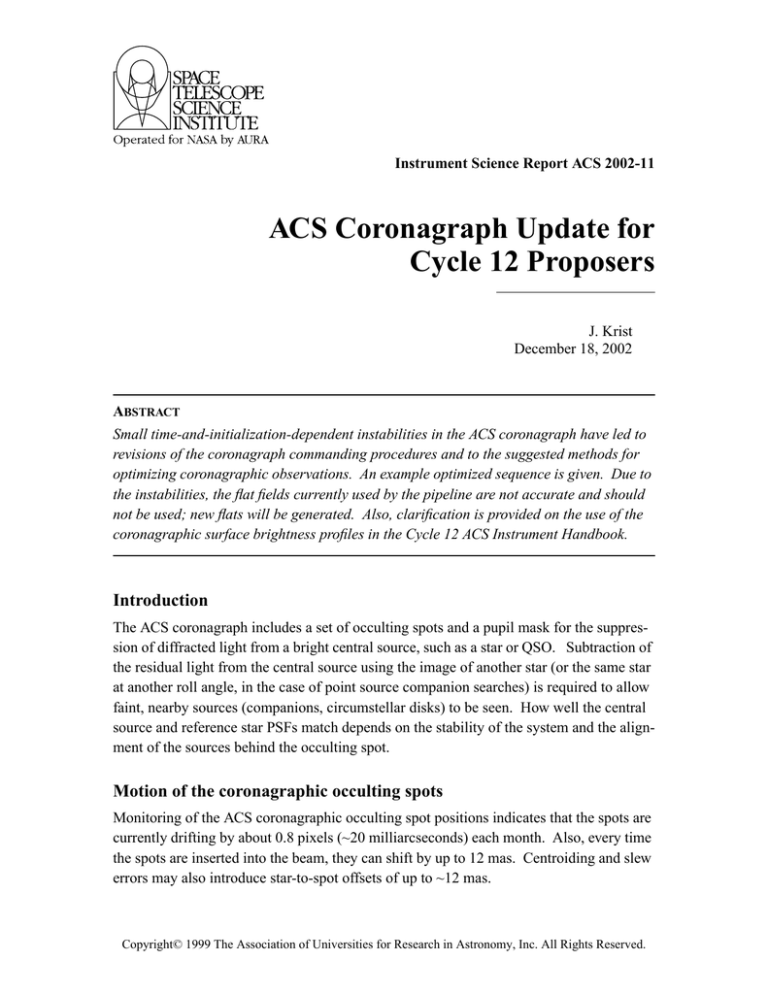
Instrument Science Report ACS 2002-11
ACS Coronagraph Update for
Cycle 12 Proposers
J. Krist
December 18, 2002
ABSTRACT
Small time-and-initialization-dependent instabilities in the ACS coronagraph have led to
revisions of the coronagraph commanding procedures and to the suggested methods for
optimizing coronagraphic observations. An example optimized sequence is given. Due to
the instabilities, the flat fields currently used by the pipeline are not accurate and should
not be used; new flats will be generated. Also, clarification is provided on the use of the
coronagraphic surface brightness profiles in the Cycle 12 ACS Instrument Handbook.
Introduction
The ACS coronagraph includes a set of occulting spots and a pupil mask for the suppression of diffracted light from a bright central source, such as a star or QSO. Subtraction of
the residual light from the central source using the image of another star (or the same star
at another roll angle, in the case of point source companion searches) is required to allow
faint, nearby sources (companions, circumstellar disks) to be seen. How well the central
source and reference star PSFs match depends on the stability of the system and the alignment of the sources behind the occulting spot.
Motion of the coronagraphic occulting spots
Monitoring of the ACS coronagraphic occulting spot positions indicates that the spots are
currently drifting by about 0.8 pixels (~20 milliarcseconds) each month. Also, every time
the spots are inserted into the beam, they can shift by up to 12 mas. Centroiding and slew
errors may also introduce star-to-spot offsets of up to ~12 mas.
Copyright© 1999 The Association of Universities for Research in Astronomy, Inc. All Rights Reserved.
Instrument Science Report ACS 2002-11
All of these offsets may seem small, given that the smaller spot is 1.8" in diameter, but the
distribution of residual light from the occulted central source is somewhat dependent on
the location of the source relative to the spot. For instance, say a star is observed and happens to end up exactly at the center of the spot. Then another star is observed whose
image will be used for PSF subtraction, but it ends up 10 mas from the spot center due to
the errors identified above. When the second star is subtracted from the first, there will be
visible residuals due to the differences in the PSFs caused by the star-to-spot position differences (as well as from any color and focus mismatches).
Revised coronagraphic mode commanding
To reduce these position-dependent errors, the ACS coronagraphic commanding sequence
has been altered (which is invisible to observers), and an optimized observation strategy
has been developed. While observers are not required to use this new strategy, they are
strongly encouraged to do so.
All coronagraphic observations begin with the acquisition and centroiding of the star (not
to be confused with guide star acquisition). Before December 2002, every acquisition
occurred without the spots in the beam. After the star was acquired, the spots were
inserted and the star moved to the official aperture location of the spot (whether that is precisely where the spot actually was depended on how up-to-date the aperture locations
were, due to spot drift). The spots were moved out of the beam when the next non-coronagraphic observation was taken or another coronagraphic acquisition was done (such as
after rolling the telescope around the star). So, the spots could end up in a slightly different position when a new target (say, a reference PSF star) was observed, even if it was in
an adjacent orbit.
Acquisitions are now done with the spots in the beam (the acquisition box has been shifted
to avoid the spots). The spots are only moved out when the next non-coronagraphic image
is taken. So, when one observes multiple targets in adjacent orbits with the coronagraph,
and does not take any direct images, the spots will stay in place, removing one source of
star-to-spot position error. Of course, this means that only that particular sequence of target observations are internally consistent with respect to the spot-insertion offset.
Also, the centering box size used during acquisition has been expanded to 5 by 5 pixels,
which provides slightly more accurate positions.
2
Instrument Science Report ACS 2002-11
Optimized observation strategy : grouping targets
NOTE: The RPS2 directives given in this section might be different from the ones in the
new Phase 2 proposal system being used for the first time in Cycle 12. Please refer to the
Cycle 12 Phase 2 proposal instructions for the corresponding directives.
To make best use of the procedures, observers must group their science and reference PSF
targets into adjacent orbits without any interleaved direct-mode observations. This has
other benefits besides eliminating spot insertion error. By observing close in time, the spot
will be at the same location for all of the targets in the sequence, negating spot drift errors
(the performance of the coronagraph itself is not really affected by these small offsets, just
the distribution pattern of the residual light from the central source that causes mismatches
between the PSFs). Also, focus variations may be reduced, especially if all of the targets
are located in the same region of the sky, due to the avoidance of large thermal changes
caused by different pointing attitudes.
Targets can be forced into adjacent orbits by using time sequencing constraints in RPS2.
These include :
AFTER <visit> BY <time1> TO <time2>
GROUP <visit-list> WITHIN <time>
SEQ <visit-list> WITHIN <time>
These visit constraints are described in the Special Requirements section of the HST
Phase 2 Proposal Instructions. The scheduling software is being modified to prevent taking daily dark and bias images during occultations within a coronagraphic sequence,
which otherwise would cause the spots to be moved out of the beam.
Here is an example of using this observation sequence:
A star with a circumstellar disk is to be observed with the ACS coronagraph, as well as
another star that will be used for PSF subtraction. A coronagraphic acquisition is first
done to place the star behind the spot. Then, a series of coronagraphic images are taken.
The exposure sequence consists of one orbit of F606W images and another in F814W.
These two orbits define the first visit. Next, another visit is defined that repeats the same
sequence of observations, but with a roll offset of 28 to 30 degrees from the first visit
(using the visit special requirement ORIENT <angle1> TO <angle2> FROM <visit>).
This roll will allow disk structure (which appears to rotate) to be distinguished from PSF
artifacts (which remain fixed within the image regardless of roll). The two visits can be
forced into adjacent orbits using the AFTER <visit> BY <time1> TO <time2> visit special requirement, with a range of between one and two hours (an HST orbit is about 97
3
Instrument Science Report ACS 2002-11
minutes). Next, a new visit is defined for the reference PSF star. Because it is brighter
than the science target, we can obtain images in both filters within one orbit. A roll is not
needed for the reference star. We can then force the two science visits and one reference
PSF visit into a block of adjacent orbits using the SEQ or GROUP visit special
requirements.
Limitations on target grouping
The scheduling of SAA passages limits the number of adjacent orbits a grouping can have
to about 5, so an observer must be careful to include a suitable reference PSF within each
group. Ideally, all objects within the group would have the same color so that the same
reference PSF can be used.
Rolling within an orbit
Starting in Cycle 12, observers will be able to roll the telescope around their target within
an orbit, providing two observation orientations within an orbit (previously, rolls had to
occur between orbits). Each roll position must have its own visit, limited to a maximum
period of 22 minutes using the VISIBILITY INTERVAL 22M visit requirement. Also, the
two visits must be forced into the same orbit using a timing constraint, such as requiring
the second visit to occur right after the first using AFTER <visit1> BY 15M to 45M.
Other observation sequence notes
By observing targets that are all within 10-20 degrees of each other, you can reduce the
differences in the orbital breathing (focus change) pattern caused by heating of the telescope during earth occultations. In this case it may be advantageous to sequence science
and PSF target observations to match the orbital phase. For instance, if the first half of an
orbit is spent on a science target taking F555W images and then the second taking F814W,
repeat that order for the reference PSF images - the two would then likely match up well in
terms of breathing.
It may be difficult to schedule observations within adjacent orbits if the targets are located
more than ~45 degrees from each other.
In all circumstances, observers should take their own reference PSFs and not rely on ones
from other programs. Group targets so that they have very similar colors as well (ie. adjacent color (e.g. V-R, B-V) differences of <0.15 mag).
4
Instrument Science Report ACS 2002-11
Flat fields and pipeline calibration
The coronagraphic flat fields ("corflats") are different from normal HRC flats, which cannot be used to flatten coronagraphic data. Corflats include the occulting spots, artifacts
caused by dust on the spots’ glass substrate, and the vignetting pattern caused by the coronagraphic Lyot stop. The corflats currently in the pipeline (as of December 2002) are
from pre-launch tests of the camera and are NOT valid. During launch, the mechanism
on which the coronagraphic masks are mounted shifted by nearly one arcsecond, and it
has been drifting by about 20 mas per month since then. Hence, the flat field pattern has
also been shifting relative to the detector.
Corflats have only been measured on-orbit for the shortest wavelength filters by looking at
the Earth. Even then, they are valid only for the particular time during which they were
taken, due to the mechanism drifts. It is likely that corflats will have to be generated manually for a given set of observations by shifting the ground-based measurements relative to
the pixel-to-pixel detector response pattern. Monthly monitoring allows the spot positions
to be measured by observing their silhouettes against a nebula.
UNTIL THE SPOT POSITIONS STABILIZE, FLAT FIELDED PIPELINE DATA
SHOULD NOT BE USED. Updates on the availability and accuracy of new ACS coronagraphic flat fields will be provided to the community in the coming year.
Clarification of the coronagraph section of the Cycle 12 ACS Handbook
Some may be confused in regards to estimating exposure times for coronagraphic observations using Figure 5.8 (which is included here as Figure 1). Those plots show the surface
brightness of the residual light from the occulted central source (Coronagraph only). They
can be used to determine background levels and estimate when saturation will begin. Take
note that the units are relative to the total flux from the central source as it would be measured in the HRC WITHOUT the coronagraph. So, multiply the estimated central source
flux from a normal HRC observation by the value on this graph to get the surface brightness as viewed with the coronagraph in place. On the other hand, when predicting fluxes
of sources not behind the spot but in the coronagraphic mode (e.g. a companion star or
disk), multiply their direct-mode flux by 0.475 to account for the reduced throughput
caused by the Lyot stop.
5
Instrument Science Report ACS 2002-11
1.8" Spot Profiles
Flux / Arcsec2 / FluxStar
10-2
F435W
F814W
10-4
Direct (no coronagraph)
10-6
Coronagraph only
Coronagraph - star
10-8
10-10
0
2
8
F435W
F814W
10-4
Direct (no coronagraph)
10-6
Coronagraph only
10-8
10-10
6
3.0" Spot Profiles
10-2
Flux / Arcsec2 / Fluxstar
4
Arcsec
Coronagraph - star
0
2
4
Arcsec
6
8
Figure 1: Coronagraphic surface brightness plots of an occulted source derived by computing the median value at each radius. The brightness units are relative to the total flux of
the star. The direct (no coronagraph) profile is predicted; the coronagraphic profiles are
measured from on-orbit images of Arcturus.
Acknowledgements
A good deal of work was done to implement the new configuration sequence and acquisition apertures in a timely manner. Those involved include Merle Reinhart, Alan Welty,
Denise Taylor, Colin Cox, and Mark Clampin.
6


